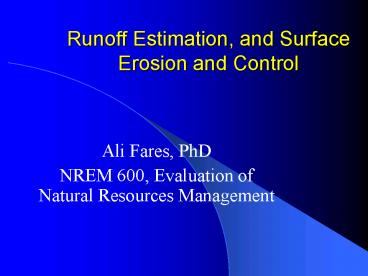Runoff Estimation, and Surface Erosion and Control - PowerPoint PPT Presentation
Title:
Runoff Estimation, and Surface Erosion and Control
Description:
Runoff Estimation, and Surface Erosion and Control Ali Fares, PhD NREM 600, Evaluation of Natural Resources Management Runoff Estimation, and Surface Erosion and ... – PowerPoint PPT presentation
Number of Views:77
Avg rating:3.0/5.0
Title: Runoff Estimation, and Surface Erosion and Control
1
Runoff Estimation, and Surface Erosion and Control
- Ali Fares, PhD
- NREM 600, Evaluation of Natural Resources
Management
2
Runoff Estimation, and Surface Erosion and Control
- Ali Fares, PhD
- Watershed Hydrology, NREM662
- UHM-CTAHR-NREM
3
Runoff Estimation
- What are the factors that affect runoff?
4
TR55 CN Method
- The SCS has developed a method of determining
excess rain based on precipitation depth (P). The
model developed by the SCS separates
precipitation into three categories - Q - Direct runoff (excess rain) This is the depth
(in) of rain that shows up as runoff. - F - Actual retention. This is the depth (in) of
the abstraction - Ia - Initial abstraction This is the depth (in)
of rain that must fall before runoff starts.
5
SCS Runoff Equation
- Where Q runoff (in)
- P rainfall (in)
- S potential maximum retention after runoff
begins (in) and - Ia initial abstraction (in)
6
- Ia is all losses before runoff begins it
includes - water retained in surface depressions,
- Water interception by vegetation
- Evaporation and infiltration.
- Ia was found to follow Ia 0.2S
7
Potential Maximum Retention
- S is related to the soil cover conditions of the
watershed through the CN. - CN has a range of 0 to 100
8
(No Transcript)
9
- The ultimate total retention, S, and the initial
abstraction, Ia, are assumed to be dependent on
the following properties of the drainage basin - Land use
- Soil Type A, B, C, D
- Soil group A Well drained sand or gravel, high
infiltration rate - Soil group B Moderately well drained soil,
moderate infiltration rate, with fine to
moderately coarse texture - Soil group C Slow infiltration rate, moderate
to fine texture - Soil group D Very slow infiltration, mainly
clay material, relatively impervious - Hydrologic condition good/fair/poor (rural land
use only) - Antecedent moisture condition (AMC)
- AMC I Dry soil
- AMC II Average soil moisture
- AMC III Wet soil
10
(No Transcript)
11
(No Transcript)
12
(No Transcript)
13
(No Transcript)
14
(No Transcript)
15
(No Transcript)
16
- Example Use the graphical solution curve to
determine the 100-year, 24-hour depth of runoff
for a basin with ½-ac lots on a B soil. Use the
100-year, NRC IDF data for the precipitation
depth. - Compute precipitation depth
- CN 80.0
17
(No Transcript)
18
(No Transcript)
19
(No Transcript)































